Standard Chemical Company: Evaluating the Drug Testing Policy Issues
VerifiedAdded on 2022/12/15
|9
|2117
|464
Report
AI Summary
This report examines the drug testing issues at Standard Chemical, focusing on the case of Peter Carpenter. The analysis begins by assessing the justification of Carpenter's suspension and subsequent termination, arguing that both were unwarranted due to a lack of evidence and ethical breaches. The report critiques the company's drug and alcohol abuse policy, highlighting its weaknesses in recognizing different drug penalties, its reliance on biased procedures, and its failure to prioritize rehabilitation over termination. The report also discusses the violation of Carpenter's privacy rights, particularly concerning the unauthorized disclosure of his medical information and the company's disregard for HIPPA regulations. The report emphasizes the importance of unbiased HR practices, adherence to privacy laws, and the prioritization of employee rehabilitation in workplace drug testing policies, supported by references to relevant literature on human resource management and ethical considerations.
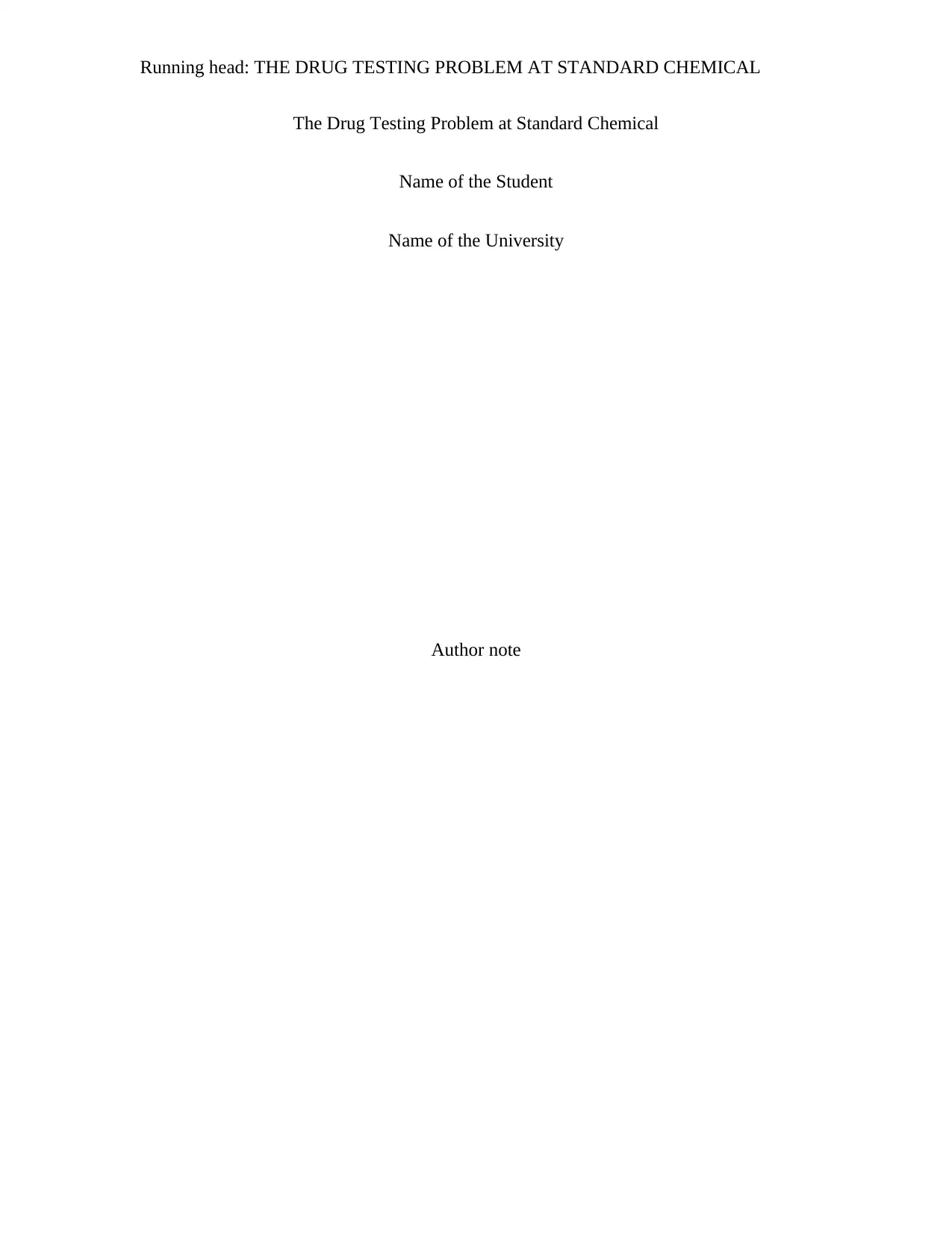
Running head: THE DRUG TESTING PROBLEM AT STANDARD CHEMICAL
The Drug Testing Problem at Standard Chemical
Name of the Student
Name of the University
Author note
The Drug Testing Problem at Standard Chemical
Name of the Student
Name of the University
Author note
Paraphrase This Document
Need a fresh take? Get an instant paraphrase of this document with our AI Paraphraser
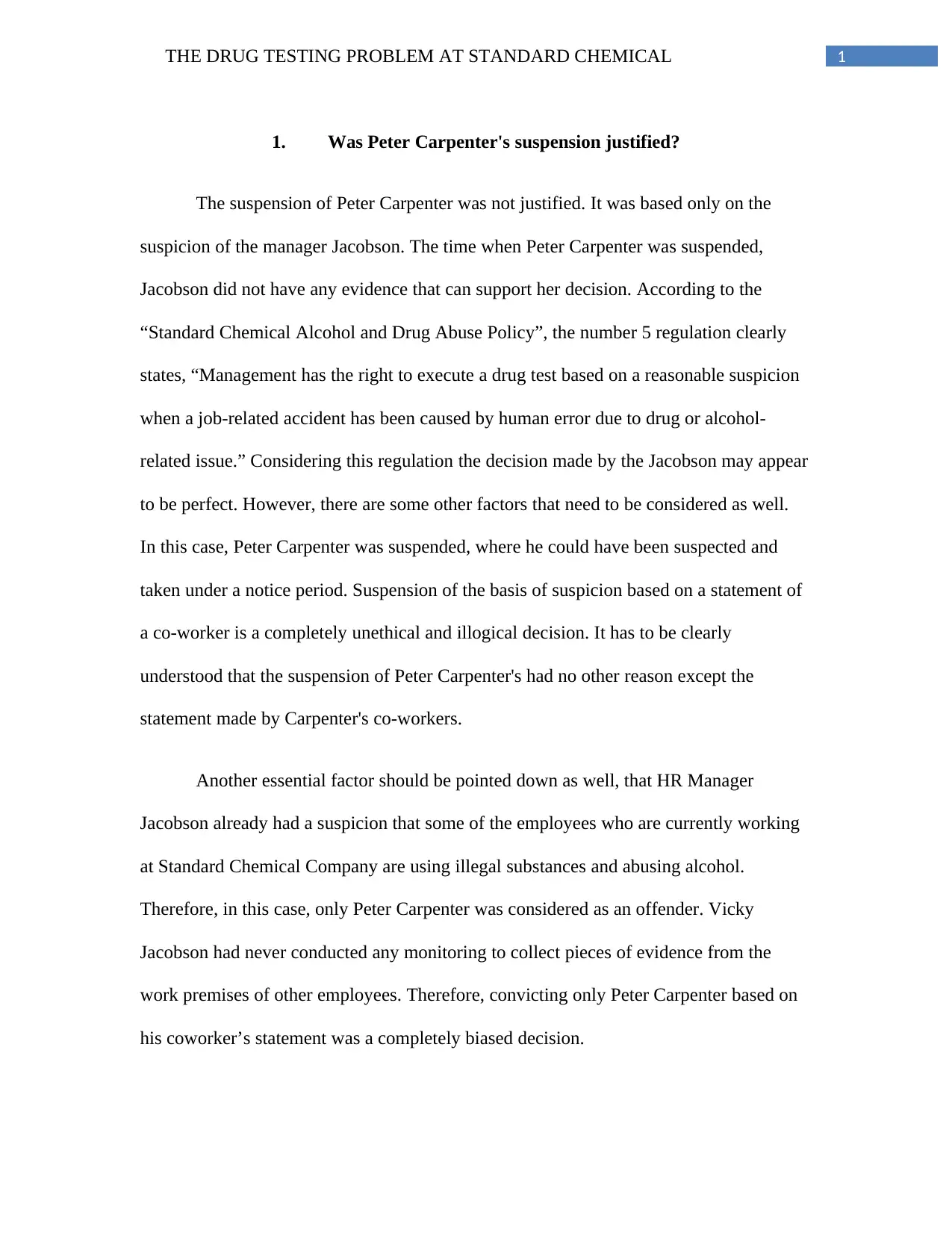
1THE DRUG TESTING PROBLEM AT STANDARD CHEMICAL
1. Was Peter Carpenter's suspension justified?
The suspension of Peter Carpenter was not justified. It was based only on the
suspicion of the manager Jacobson. The time when Peter Carpenter was suspended,
Jacobson did not have any evidence that can support her decision. According to the
“Standard Chemical Alcohol and Drug Abuse Policy”, the number 5 regulation clearly
states, “Management has the right to execute a drug test based on a reasonable suspicion
when a job-related accident has been caused by human error due to drug or alcohol-
related issue.” Considering this regulation the decision made by the Jacobson may appear
to be perfect. However, there are some other factors that need to be considered as well.
In this case, Peter Carpenter was suspended, where he could have been suspected and
taken under a notice period. Suspension of the basis of suspicion based on a statement of
a co-worker is a completely unethical and illogical decision. It has to be clearly
understood that the suspension of Peter Carpenter's had no other reason except the
statement made by Carpenter's co-workers.
Another essential factor should be pointed down as well, that HR Manager
Jacobson already had a suspicion that some of the employees who are currently working
at Standard Chemical Company are using illegal substances and abusing alcohol.
Therefore, in this case, only Peter Carpenter was considered as an offender. Vicky
Jacobson had never conducted any monitoring to collect pieces of evidence from the
work premises of other employees. Therefore, convicting only Peter Carpenter based on
his coworker’s statement was a completely biased decision.
1. Was Peter Carpenter's suspension justified?
The suspension of Peter Carpenter was not justified. It was based only on the
suspicion of the manager Jacobson. The time when Peter Carpenter was suspended,
Jacobson did not have any evidence that can support her decision. According to the
“Standard Chemical Alcohol and Drug Abuse Policy”, the number 5 regulation clearly
states, “Management has the right to execute a drug test based on a reasonable suspicion
when a job-related accident has been caused by human error due to drug or alcohol-
related issue.” Considering this regulation the decision made by the Jacobson may appear
to be perfect. However, there are some other factors that need to be considered as well.
In this case, Peter Carpenter was suspended, where he could have been suspected and
taken under a notice period. Suspension of the basis of suspicion based on a statement of
a co-worker is a completely unethical and illogical decision. It has to be clearly
understood that the suspension of Peter Carpenter's had no other reason except the
statement made by Carpenter's co-workers.
Another essential factor should be pointed down as well, that HR Manager
Jacobson already had a suspicion that some of the employees who are currently working
at Standard Chemical Company are using illegal substances and abusing alcohol.
Therefore, in this case, only Peter Carpenter was considered as an offender. Vicky
Jacobson had never conducted any monitoring to collect pieces of evidence from the
work premises of other employees. Therefore, convicting only Peter Carpenter based on
his coworker’s statement was a completely biased decision.
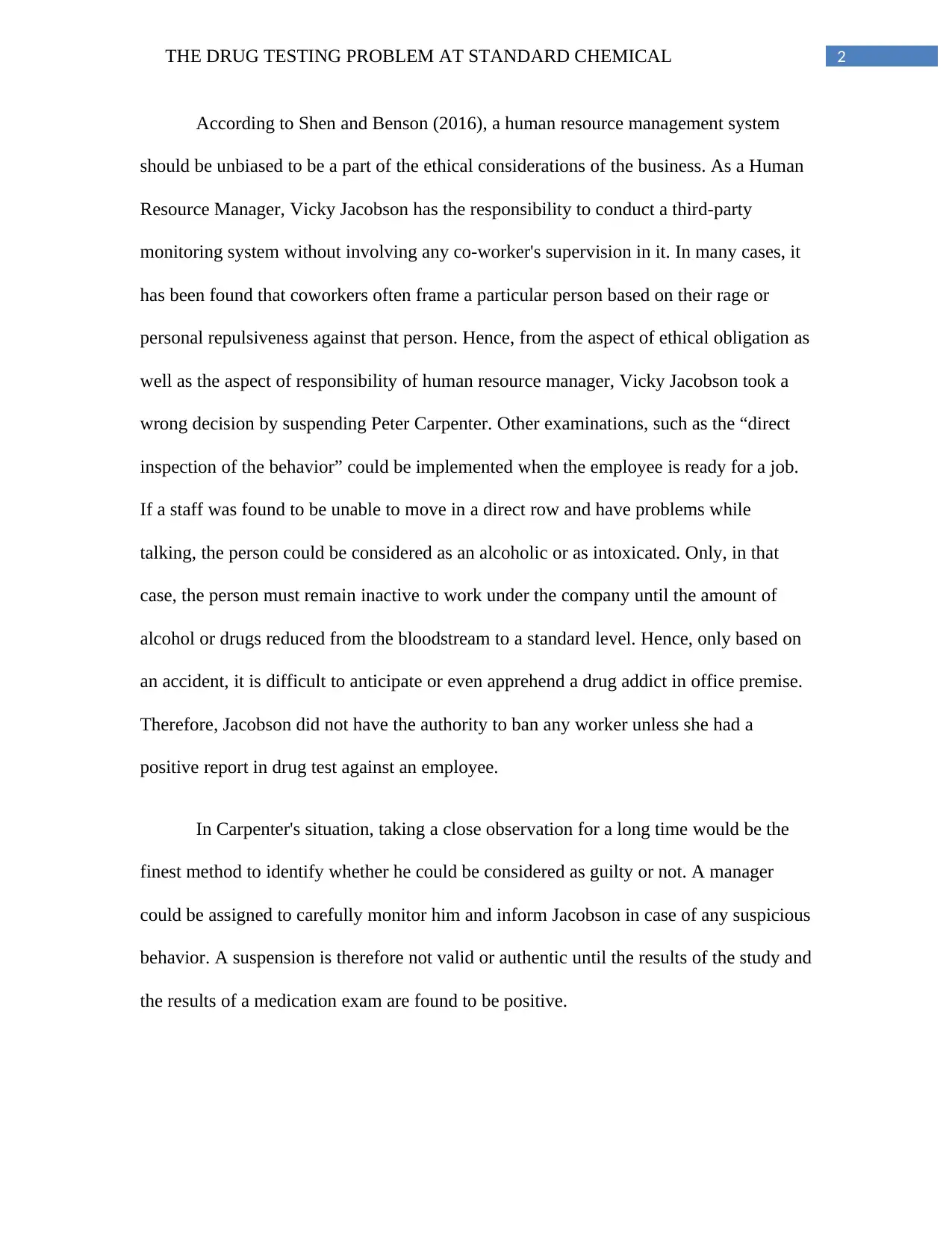
2THE DRUG TESTING PROBLEM AT STANDARD CHEMICAL
According to Shen and Benson (2016), a human resource management system
should be unbiased to be a part of the ethical considerations of the business. As a Human
Resource Manager, Vicky Jacobson has the responsibility to conduct a third-party
monitoring system without involving any co-worker's supervision in it. In many cases, it
has been found that coworkers often frame a particular person based on their rage or
personal repulsiveness against that person. Hence, from the aspect of ethical obligation as
well as the aspect of responsibility of human resource manager, Vicky Jacobson took a
wrong decision by suspending Peter Carpenter. Other examinations, such as the “direct
inspection of the behavior” could be implemented when the employee is ready for a job.
If a staff was found to be unable to move in a direct row and have problems while
talking, the person could be considered as an alcoholic or as intoxicated. Only, in that
case, the person must remain inactive to work under the company until the amount of
alcohol or drugs reduced from the bloodstream to a standard level. Hence, only based on
an accident, it is difficult to anticipate or even apprehend a drug addict in office premise.
Therefore, Jacobson did not have the authority to ban any worker unless she had a
positive report in drug test against an employee.
In Carpenter's situation, taking a close observation for a long time would be the
finest method to identify whether he could be considered as guilty or not. A manager
could be assigned to carefully monitor him and inform Jacobson in case of any suspicious
behavior. A suspension is therefore not valid or authentic until the results of the study and
the results of a medication exam are found to be positive.
According to Shen and Benson (2016), a human resource management system
should be unbiased to be a part of the ethical considerations of the business. As a Human
Resource Manager, Vicky Jacobson has the responsibility to conduct a third-party
monitoring system without involving any co-worker's supervision in it. In many cases, it
has been found that coworkers often frame a particular person based on their rage or
personal repulsiveness against that person. Hence, from the aspect of ethical obligation as
well as the aspect of responsibility of human resource manager, Vicky Jacobson took a
wrong decision by suspending Peter Carpenter. Other examinations, such as the “direct
inspection of the behavior” could be implemented when the employee is ready for a job.
If a staff was found to be unable to move in a direct row and have problems while
talking, the person could be considered as an alcoholic or as intoxicated. Only, in that
case, the person must remain inactive to work under the company until the amount of
alcohol or drugs reduced from the bloodstream to a standard level. Hence, only based on
an accident, it is difficult to anticipate or even apprehend a drug addict in office premise.
Therefore, Jacobson did not have the authority to ban any worker unless she had a
positive report in drug test against an employee.
In Carpenter's situation, taking a close observation for a long time would be the
finest method to identify whether he could be considered as guilty or not. A manager
could be assigned to carefully monitor him and inform Jacobson in case of any suspicious
behavior. A suspension is therefore not valid or authentic until the results of the study and
the results of a medication exam are found to be positive.
⊘ This is a preview!⊘
Do you want full access?
Subscribe today to unlock all pages.

Trusted by 1+ million students worldwide
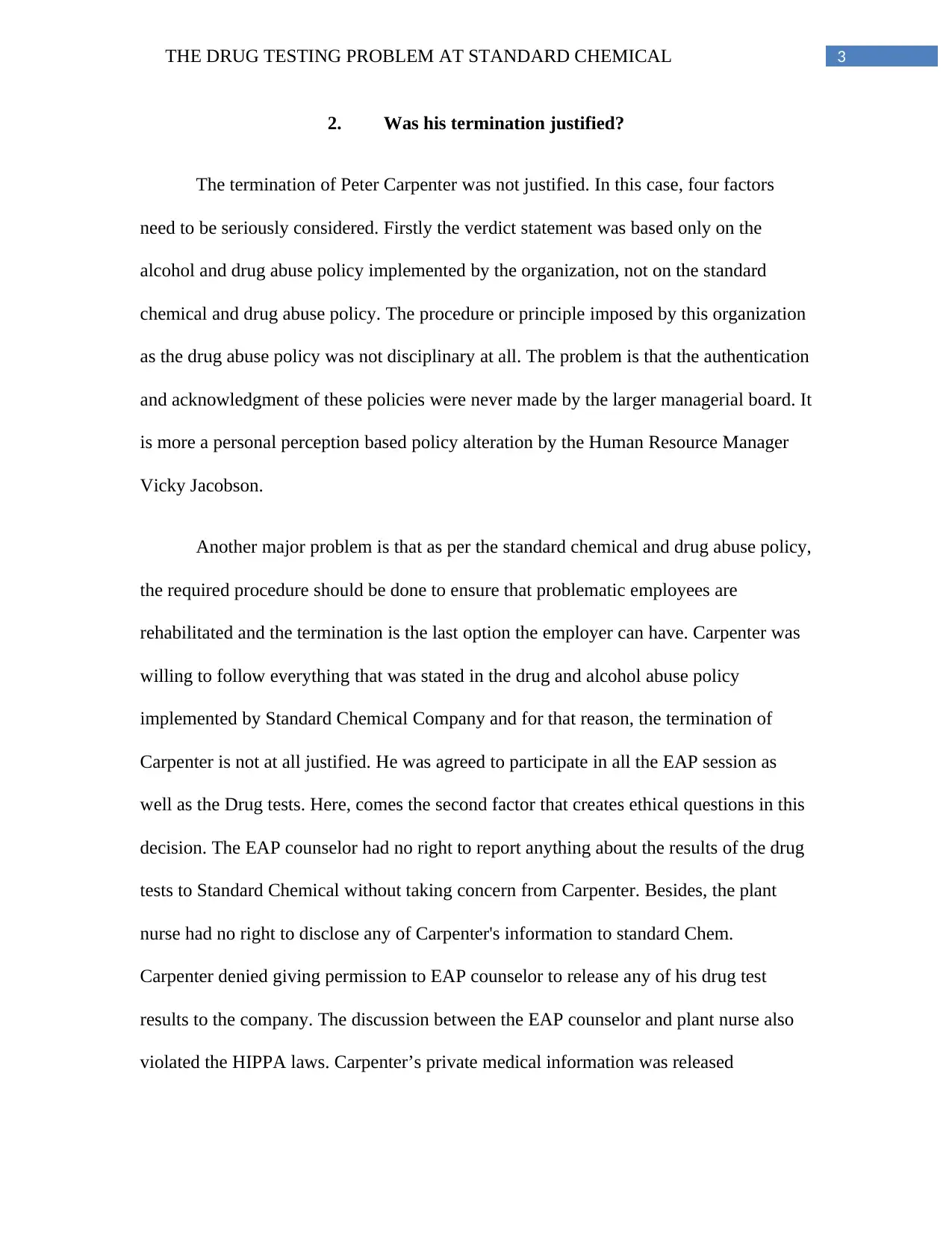
3THE DRUG TESTING PROBLEM AT STANDARD CHEMICAL
2. Was his termination justified?
The termination of Peter Carpenter was not justified. In this case, four factors
need to be seriously considered. Firstly the verdict statement was based only on the
alcohol and drug abuse policy implemented by the organization, not on the standard
chemical and drug abuse policy. The procedure or principle imposed by this organization
as the drug abuse policy was not disciplinary at all. The problem is that the authentication
and acknowledgment of these policies were never made by the larger managerial board. It
is more a personal perception based policy alteration by the Human Resource Manager
Vicky Jacobson.
Another major problem is that as per the standard chemical and drug abuse policy,
the required procedure should be done to ensure that problematic employees are
rehabilitated and the termination is the last option the employer can have. Carpenter was
willing to follow everything that was stated in the drug and alcohol abuse policy
implemented by Standard Chemical Company and for that reason, the termination of
Carpenter is not at all justified. He was agreed to participate in all the EAP session as
well as the Drug tests. Here, comes the second factor that creates ethical questions in this
decision. The EAP counselor had no right to report anything about the results of the drug
tests to Standard Chemical without taking concern from Carpenter. Besides, the plant
nurse had no right to disclose any of Carpenter's information to standard Chem.
Carpenter denied giving permission to EAP counselor to release any of his drug test
results to the company. The discussion between the EAP counselor and plant nurse also
violated the HIPPA laws. Carpenter’s private medical information was released
2. Was his termination justified?
The termination of Peter Carpenter was not justified. In this case, four factors
need to be seriously considered. Firstly the verdict statement was based only on the
alcohol and drug abuse policy implemented by the organization, not on the standard
chemical and drug abuse policy. The procedure or principle imposed by this organization
as the drug abuse policy was not disciplinary at all. The problem is that the authentication
and acknowledgment of these policies were never made by the larger managerial board. It
is more a personal perception based policy alteration by the Human Resource Manager
Vicky Jacobson.
Another major problem is that as per the standard chemical and drug abuse policy,
the required procedure should be done to ensure that problematic employees are
rehabilitated and the termination is the last option the employer can have. Carpenter was
willing to follow everything that was stated in the drug and alcohol abuse policy
implemented by Standard Chemical Company and for that reason, the termination of
Carpenter is not at all justified. He was agreed to participate in all the EAP session as
well as the Drug tests. Here, comes the second factor that creates ethical questions in this
decision. The EAP counselor had no right to report anything about the results of the drug
tests to Standard Chemical without taking concern from Carpenter. Besides, the plant
nurse had no right to disclose any of Carpenter's information to standard Chem.
Carpenter denied giving permission to EAP counselor to release any of his drug test
results to the company. The discussion between the EAP counselor and plant nurse also
violated the HIPPA laws. Carpenter’s private medical information was released
Paraphrase This Document
Need a fresh take? Get an instant paraphrase of this document with our AI Paraphraser
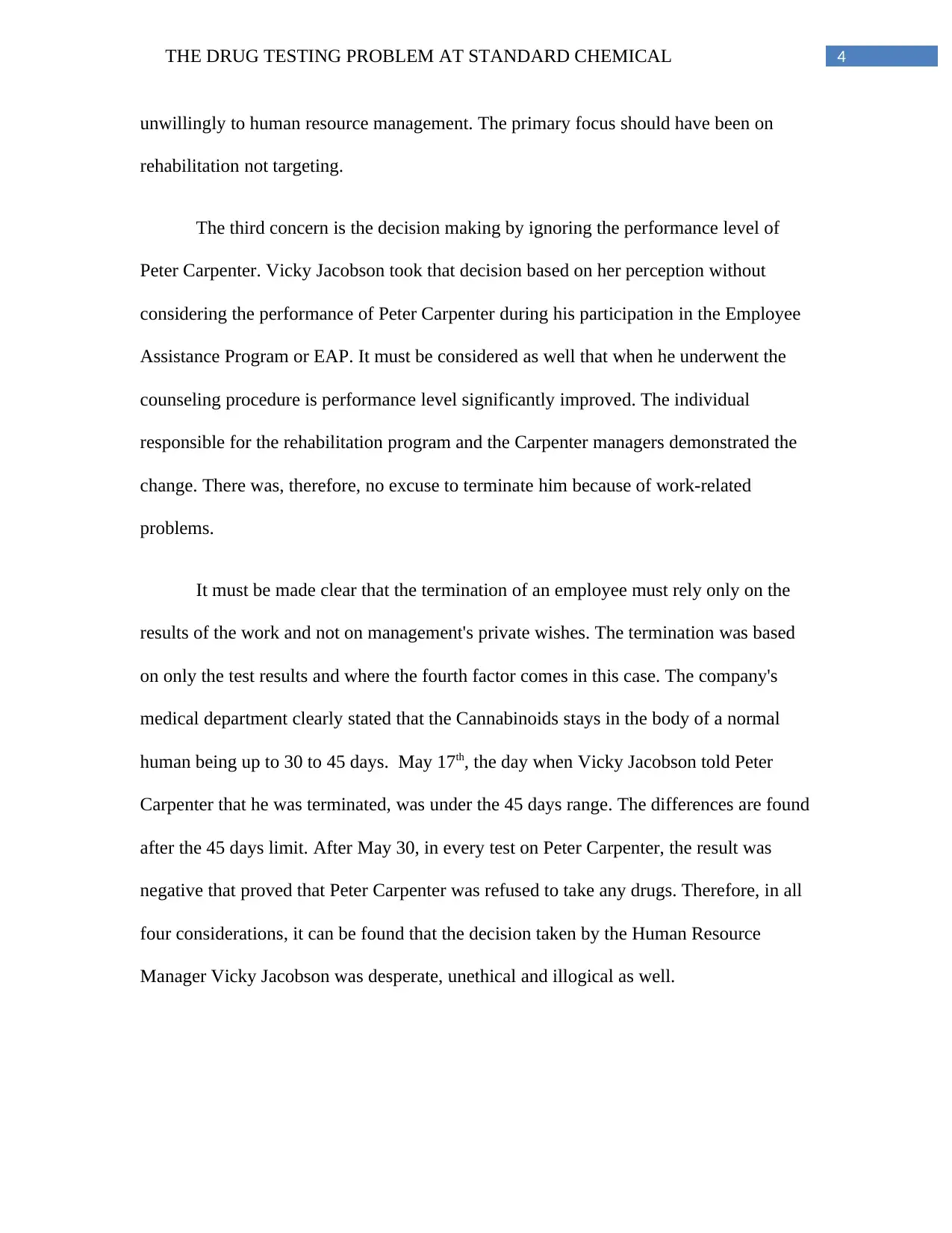
4THE DRUG TESTING PROBLEM AT STANDARD CHEMICAL
unwillingly to human resource management. The primary focus should have been on
rehabilitation not targeting.
The third concern is the decision making by ignoring the performance level of
Peter Carpenter. Vicky Jacobson took that decision based on her perception without
considering the performance of Peter Carpenter during his participation in the Employee
Assistance Program or EAP. It must be considered as well that when he underwent the
counseling procedure is performance level significantly improved. The individual
responsible for the rehabilitation program and the Carpenter managers demonstrated the
change. There was, therefore, no excuse to terminate him because of work-related
problems.
It must be made clear that the termination of an employee must rely only on the
results of the work and not on management's private wishes. The termination was based
on only the test results and where the fourth factor comes in this case. The company's
medical department clearly stated that the Cannabinoids stays in the body of a normal
human being up to 30 to 45 days. May 17th, the day when Vicky Jacobson told Peter
Carpenter that he was terminated, was under the 45 days range. The differences are found
after the 45 days limit. After May 30, in every test on Peter Carpenter, the result was
negative that proved that Peter Carpenter was refused to take any drugs. Therefore, in all
four considerations, it can be found that the decision taken by the Human Resource
Manager Vicky Jacobson was desperate, unethical and illogical as well.
unwillingly to human resource management. The primary focus should have been on
rehabilitation not targeting.
The third concern is the decision making by ignoring the performance level of
Peter Carpenter. Vicky Jacobson took that decision based on her perception without
considering the performance of Peter Carpenter during his participation in the Employee
Assistance Program or EAP. It must be considered as well that when he underwent the
counseling procedure is performance level significantly improved. The individual
responsible for the rehabilitation program and the Carpenter managers demonstrated the
change. There was, therefore, no excuse to terminate him because of work-related
problems.
It must be made clear that the termination of an employee must rely only on the
results of the work and not on management's private wishes. The termination was based
on only the test results and where the fourth factor comes in this case. The company's
medical department clearly stated that the Cannabinoids stays in the body of a normal
human being up to 30 to 45 days. May 17th, the day when Vicky Jacobson told Peter
Carpenter that he was terminated, was under the 45 days range. The differences are found
after the 45 days limit. After May 30, in every test on Peter Carpenter, the result was
negative that proved that Peter Carpenter was refused to take any drugs. Therefore, in all
four considerations, it can be found that the decision taken by the Human Resource
Manager Vicky Jacobson was desperate, unethical and illogical as well.
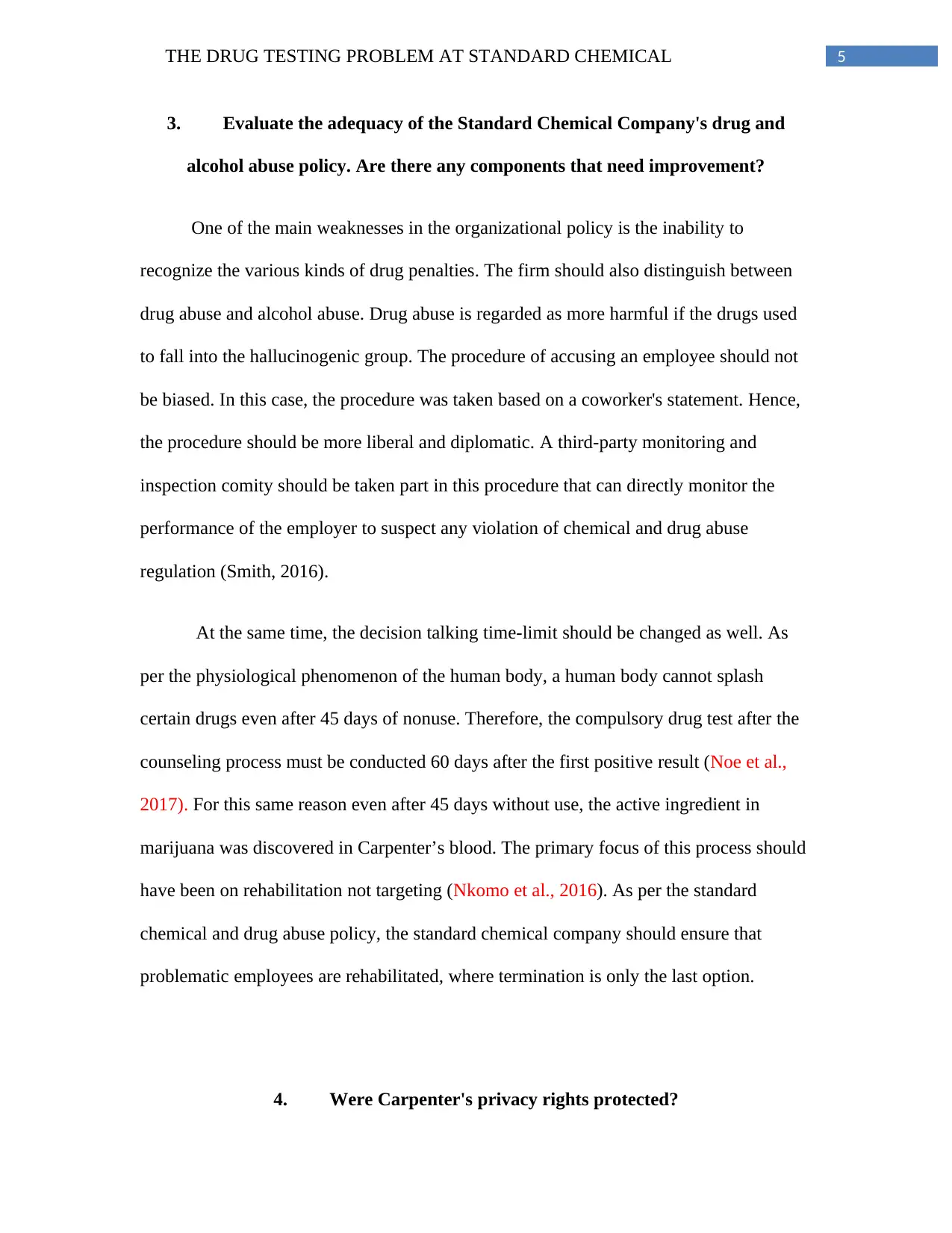
5THE DRUG TESTING PROBLEM AT STANDARD CHEMICAL
3. Evaluate the adequacy of the Standard Chemical Company's drug and
alcohol abuse policy. Are there any components that need improvement?
One of the main weaknesses in the organizational policy is the inability to
recognize the various kinds of drug penalties. The firm should also distinguish between
drug abuse and alcohol abuse. Drug abuse is regarded as more harmful if the drugs used
to fall into the hallucinogenic group. The procedure of accusing an employee should not
be biased. In this case, the procedure was taken based on a coworker's statement. Hence,
the procedure should be more liberal and diplomatic. A third-party monitoring and
inspection comity should be taken part in this procedure that can directly monitor the
performance of the employer to suspect any violation of chemical and drug abuse
regulation (Smith, 2016).
At the same time, the decision talking time-limit should be changed as well. As
per the physiological phenomenon of the human body, a human body cannot splash
certain drugs even after 45 days of nonuse. Therefore, the compulsory drug test after the
counseling process must be conducted 60 days after the first positive result (Noe et al.,
2017). For this same reason even after 45 days without use, the active ingredient in
marijuana was discovered in Carpenter’s blood. The primary focus of this process should
have been on rehabilitation not targeting (Nkomo et al., 2016). As per the standard
chemical and drug abuse policy, the standard chemical company should ensure that
problematic employees are rehabilitated, where termination is only the last option.
4. Were Carpenter's privacy rights protected?
3. Evaluate the adequacy of the Standard Chemical Company's drug and
alcohol abuse policy. Are there any components that need improvement?
One of the main weaknesses in the organizational policy is the inability to
recognize the various kinds of drug penalties. The firm should also distinguish between
drug abuse and alcohol abuse. Drug abuse is regarded as more harmful if the drugs used
to fall into the hallucinogenic group. The procedure of accusing an employee should not
be biased. In this case, the procedure was taken based on a coworker's statement. Hence,
the procedure should be more liberal and diplomatic. A third-party monitoring and
inspection comity should be taken part in this procedure that can directly monitor the
performance of the employer to suspect any violation of chemical and drug abuse
regulation (Smith, 2016).
At the same time, the decision talking time-limit should be changed as well. As
per the physiological phenomenon of the human body, a human body cannot splash
certain drugs even after 45 days of nonuse. Therefore, the compulsory drug test after the
counseling process must be conducted 60 days after the first positive result (Noe et al.,
2017). For this same reason even after 45 days without use, the active ingredient in
marijuana was discovered in Carpenter’s blood. The primary focus of this process should
have been on rehabilitation not targeting (Nkomo et al., 2016). As per the standard
chemical and drug abuse policy, the standard chemical company should ensure that
problematic employees are rehabilitated, where termination is only the last option.
4. Were Carpenter's privacy rights protected?
⊘ This is a preview!⊘
Do you want full access?
Subscribe today to unlock all pages.

Trusted by 1+ million students worldwide
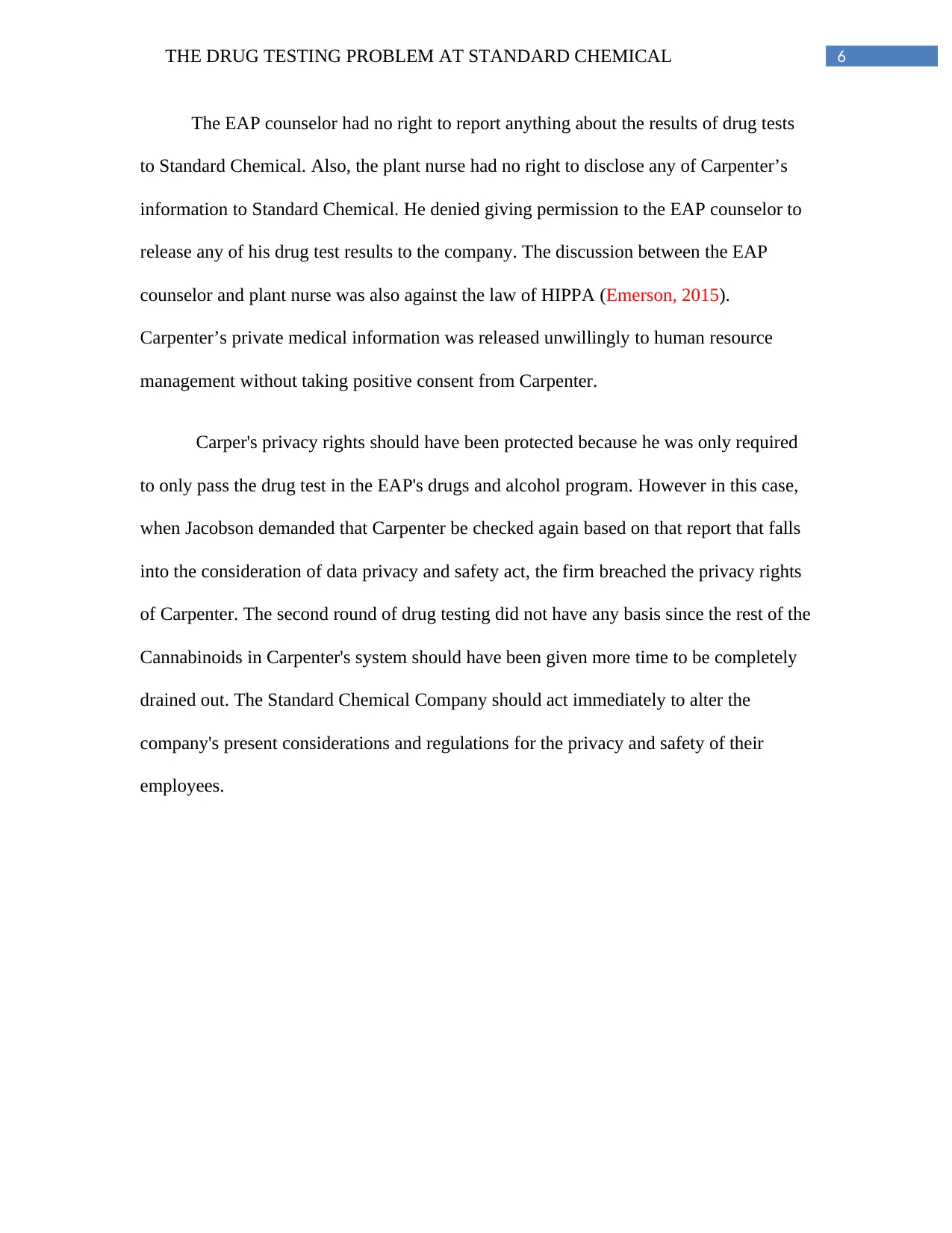
6THE DRUG TESTING PROBLEM AT STANDARD CHEMICAL
The EAP counselor had no right to report anything about the results of drug tests
to Standard Chemical. Also, the plant nurse had no right to disclose any of Carpenter’s
information to Standard Chemical. He denied giving permission to the EAP counselor to
release any of his drug test results to the company. The discussion between the EAP
counselor and plant nurse was also against the law of HIPPA (Emerson, 2015).
Carpenter’s private medical information was released unwillingly to human resource
management without taking positive consent from Carpenter.
Carper's privacy rights should have been protected because he was only required
to only pass the drug test in the EAP's drugs and alcohol program. However in this case,
when Jacobson demanded that Carpenter be checked again based on that report that falls
into the consideration of data privacy and safety act, the firm breached the privacy rights
of Carpenter. The second round of drug testing did not have any basis since the rest of the
Cannabinoids in Carpenter's system should have been given more time to be completely
drained out. The Standard Chemical Company should act immediately to alter the
company's present considerations and regulations for the privacy and safety of their
employees.
The EAP counselor had no right to report anything about the results of drug tests
to Standard Chemical. Also, the plant nurse had no right to disclose any of Carpenter’s
information to Standard Chemical. He denied giving permission to the EAP counselor to
release any of his drug test results to the company. The discussion between the EAP
counselor and plant nurse was also against the law of HIPPA (Emerson, 2015).
Carpenter’s private medical information was released unwillingly to human resource
management without taking positive consent from Carpenter.
Carper's privacy rights should have been protected because he was only required
to only pass the drug test in the EAP's drugs and alcohol program. However in this case,
when Jacobson demanded that Carpenter be checked again based on that report that falls
into the consideration of data privacy and safety act, the firm breached the privacy rights
of Carpenter. The second round of drug testing did not have any basis since the rest of the
Cannabinoids in Carpenter's system should have been given more time to be completely
drained out. The Standard Chemical Company should act immediately to alter the
company's present considerations and regulations for the privacy and safety of their
employees.
Paraphrase This Document
Need a fresh take? Get an instant paraphrase of this document with our AI Paraphraser
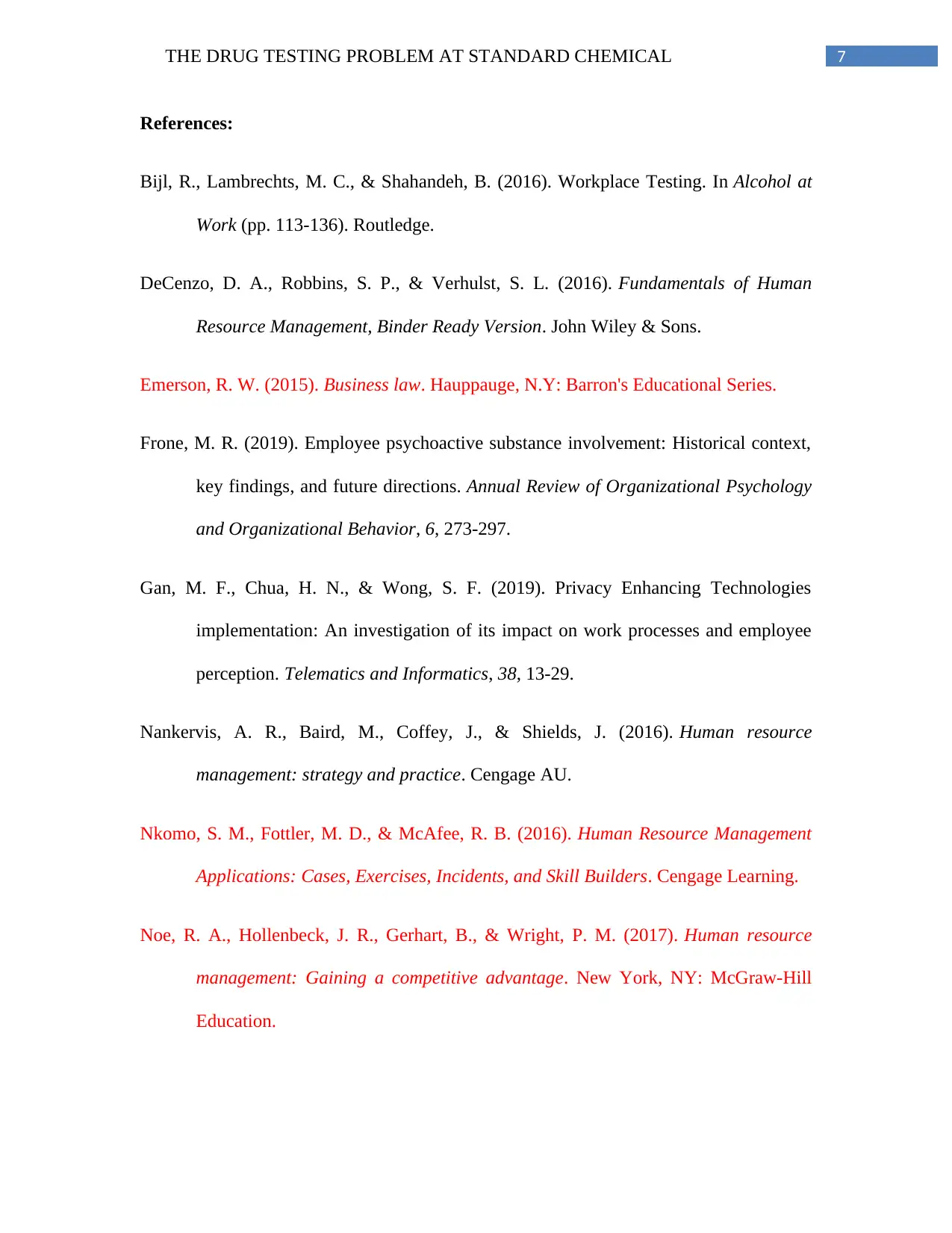
7THE DRUG TESTING PROBLEM AT STANDARD CHEMICAL
References:
Bijl, R., Lambrechts, M. C., & Shahandeh, B. (2016). Workplace Testing. In Alcohol at
Work (pp. 113-136). Routledge.
DeCenzo, D. A., Robbins, S. P., & Verhulst, S. L. (2016). Fundamentals of Human
Resource Management, Binder Ready Version. John Wiley & Sons.
Emerson, R. W. (2015). Business law. Hauppauge, N.Y: Barron's Educational Series.
Frone, M. R. (2019). Employee psychoactive substance involvement: Historical context,
key findings, and future directions. Annual Review of Organizational Psychology
and Organizational Behavior, 6, 273-297.
Gan, M. F., Chua, H. N., & Wong, S. F. (2019). Privacy Enhancing Technologies
implementation: An investigation of its impact on work processes and employee
perception. Telematics and Informatics, 38, 13-29.
Nankervis, A. R., Baird, M., Coffey, J., & Shields, J. (2016). Human resource
management: strategy and practice. Cengage AU.
Nkomo, S. M., Fottler, M. D., & McAfee, R. B. (2016). Human Resource Management
Applications: Cases, Exercises, Incidents, and Skill Builders. Cengage Learning.
Noe, R. A., Hollenbeck, J. R., Gerhart, B., & Wright, P. M. (2017). Human resource
management: Gaining a competitive advantage. New York, NY: McGraw-Hill
Education.
References:
Bijl, R., Lambrechts, M. C., & Shahandeh, B. (2016). Workplace Testing. In Alcohol at
Work (pp. 113-136). Routledge.
DeCenzo, D. A., Robbins, S. P., & Verhulst, S. L. (2016). Fundamentals of Human
Resource Management, Binder Ready Version. John Wiley & Sons.
Emerson, R. W. (2015). Business law. Hauppauge, N.Y: Barron's Educational Series.
Frone, M. R. (2019). Employee psychoactive substance involvement: Historical context,
key findings, and future directions. Annual Review of Organizational Psychology
and Organizational Behavior, 6, 273-297.
Gan, M. F., Chua, H. N., & Wong, S. F. (2019). Privacy Enhancing Technologies
implementation: An investigation of its impact on work processes and employee
perception. Telematics and Informatics, 38, 13-29.
Nankervis, A. R., Baird, M., Coffey, J., & Shields, J. (2016). Human resource
management: strategy and practice. Cengage AU.
Nkomo, S. M., Fottler, M. D., & McAfee, R. B. (2016). Human Resource Management
Applications: Cases, Exercises, Incidents, and Skill Builders. Cengage Learning.
Noe, R. A., Hollenbeck, J. R., Gerhart, B., & Wright, P. M. (2017). Human resource
management: Gaining a competitive advantage. New York, NY: McGraw-Hill
Education.
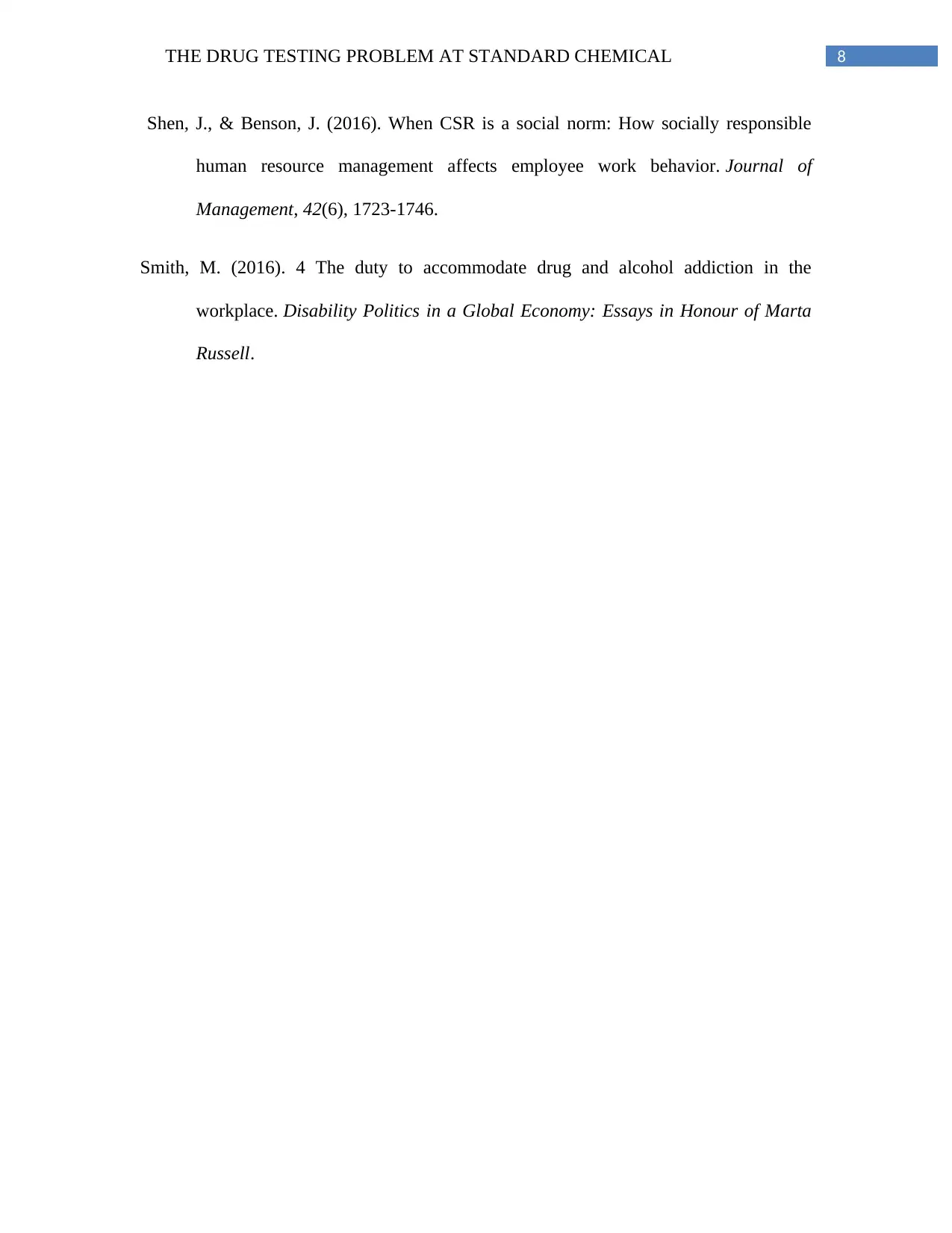
8THE DRUG TESTING PROBLEM AT STANDARD CHEMICAL
Shen, J., & Benson, J. (2016). When CSR is a social norm: How socially responsible
human resource management affects employee work behavior. Journal of
Management, 42(6), 1723-1746.
Smith, M. (2016). 4 The duty to accommodate drug and alcohol addiction in the
workplace. Disability Politics in a Global Economy: Essays in Honour of Marta
Russell.
Shen, J., & Benson, J. (2016). When CSR is a social norm: How socially responsible
human resource management affects employee work behavior. Journal of
Management, 42(6), 1723-1746.
Smith, M. (2016). 4 The duty to accommodate drug and alcohol addiction in the
workplace. Disability Politics in a Global Economy: Essays in Honour of Marta
Russell.
⊘ This is a preview!⊘
Do you want full access?
Subscribe today to unlock all pages.

Trusted by 1+ million students worldwide
1 out of 9
Your All-in-One AI-Powered Toolkit for Academic Success.
+13062052269
info@desklib.com
Available 24*7 on WhatsApp / Email
![[object Object]](/_next/static/media/star-bottom.7253800d.svg)
Unlock your academic potential
Copyright © 2020–2025 A2Z Services. All Rights Reserved. Developed and managed by ZUCOL.